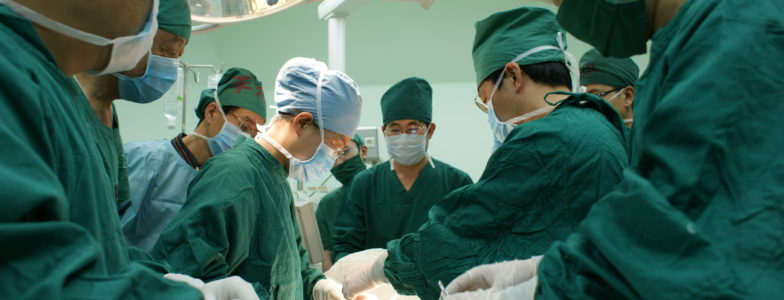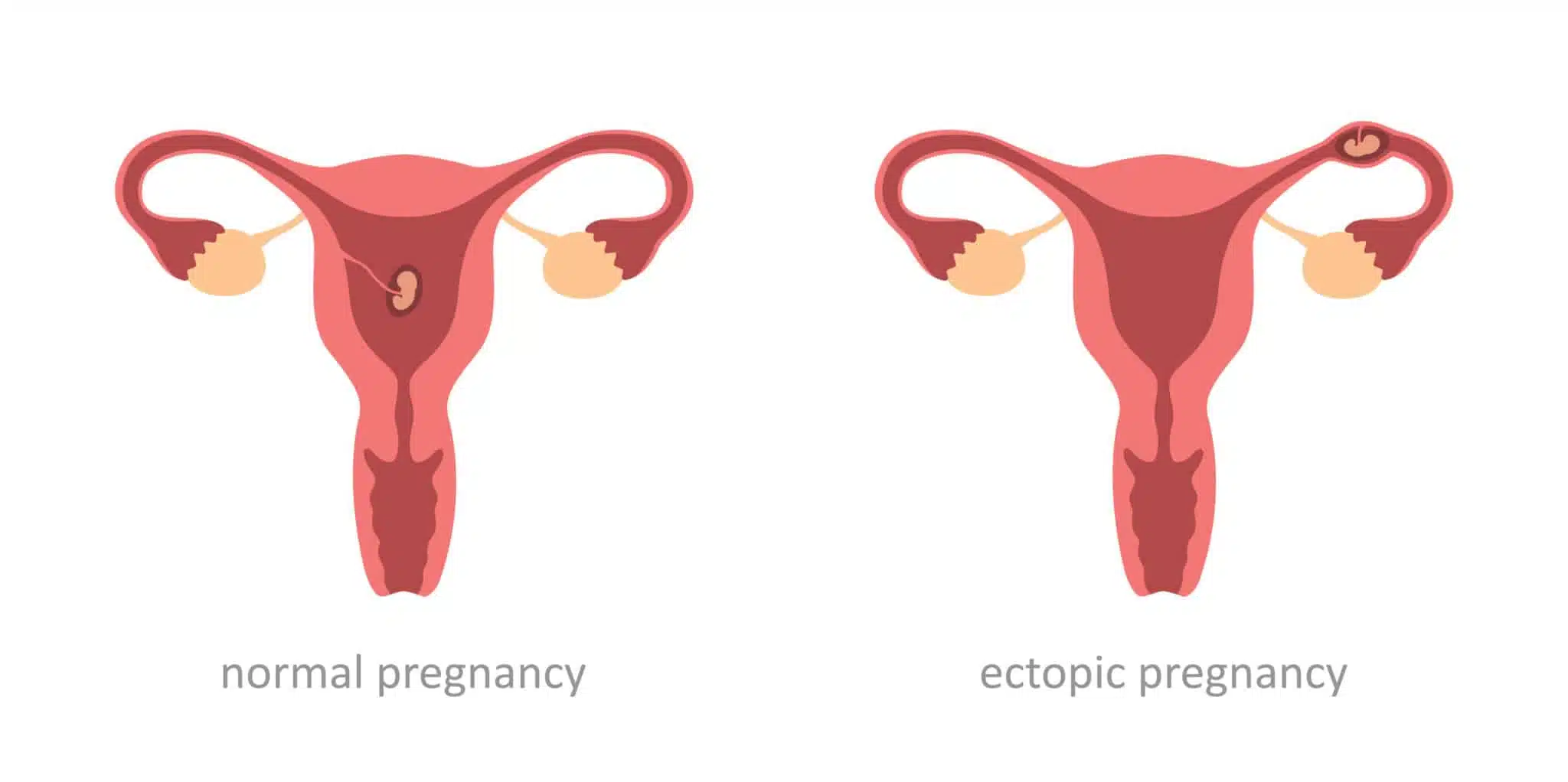The very rare cases when a pregnancy poses a genuine and immediate threat to the mother’s life are a source of great confusion, especially among Catholics.
It is absolutely true that the Catholic Church bans direct abortion in all cases. However, the mother’s life may be saved by surgery that does not directly attack the preborn baby’s life, even if the child may die as an indirect result of the procedure.
This ethical principle is known as the principle of double effect.

The most common problems that require the application of this ethical principle are ectopic pregnancy, carcinoma of the uterine cervix, and cancer of the ovary. Occasionally, cancer of the vulva or vagina may require surgical intervention.1
In such cases, under the principle of double effect, physicians must do everything in their power to save both the mother and the child. In the case of an ectopic pregnancy, if the doctors decide that the mother’s life can only be saved by removing the Fallopian tube, and with it the preborn baby, or by removal of some other tissue essential for the preborn baby’s life, the baby will certainly die. But this kind of surgery would not be categorized as an abortion. This is the critical and fundamental difference between deliberate killing (abortion) and unintentional death. The intent is not to kill the preborn child, but to save the life of the mother.
Conditions of the Principle of Double Effect
The principle of double effect states that it is morally permissible to perform an action that will produce both good and bad effects as long as the following conditions are all met. The example shown below is for the treatment of an ectopic pregnancy, where the preborn child is developing in the Fallopian tube. If the child continues to grow there, the tube will eventually rupture and will probably cause the death of both the mother and the child.2
- The goal of the surgery itself must be good or at least morally neutral. In this case, the goal of the surgery is to remove a pathological organ which presents an imminent threat to the life of the woman—a good goal. By contrast, the goal of surgical or chemical abortion is simply to kill the preborn child.
- The good effect must not come about as a result of the evil effect, but must come directly from the good action, which in this case is the surgery intended to heal. The good effect (saving the mother’s life) is not caused by the bad effect (the death of the preborn child). By contrast, in the case of direct abortion (surgical or chemical abortion), the death of the child is wrongly considered to be the “good” effect.
- The evil effect must not be desired in itself but only permitted, if there is no other choice. In the case of the removal of an ectopic pregnancy, the surgeon does not intend or want to kill the baby; the baby’s death is an unintended and unwanted side effect of the surgery. By contrast, the intent of abortion is to kill the preborn child.
- There must be a sufficiently grave reason for permitting the evil effect to occur. In this case, the reason is to save the life of the mother when all other options for saving her life have been exhausted, a good that is greater than or equal to the evil effect of the baby’s death. Pro-abortion groups often stretch this principle to absurd lengths, going so far as to justify all abortions under the principle of double effect because, as they falsely allege, most or all pregnancies threaten the life of the mother.
The principle of double effect also applies to sexual sterilization. If a non-pregnant woman must have a hysterectomy to remove a dangerously cancerous uterus, this will result in her sterilization, but is not a sinful act (provided the above conditions are met). However, if the purpose of the operation is not to heal or safeguard health, but to directly sterilize, then that act is always mortally sinful.3
Misuse of the Principle of Double Effect
Sometimes the term “therapeutic” is used to describe certain cases of abortion. Abortion is not healthcare, any more than hiring a hitman to kill someone.4 Direct abortion is never “therapy,” since it never cures anyone of an illness, but instead kills an innocent human being. “Therapeutic” abortions are sometimes allegedly performed with the intention of saving the mother’s life, but one or more of the above four conditions are not met.
Basically, the doctor in this case does have alternatives which can save both mother and her preborn child but chooses abortion as the most expedient (or inexpensive) way to solve the problem at hand.
If we ever arrive at the point where the lives of both mother and child can be saved in all such cases, the principle of double effect would become moot.5
It is a sign of the times that many pro-abortionists have stated that pregnancy itself as a disease, and present abortion as the “cure” for this dreaded malady.6
Pope Pius XII summarized the intent of double effect in 1951: “Both for the one and the other, the demand cannot be but this: To use every means to save the life of both the mother and the child.”7
The Declaration on Procured Abortion reiterates the intent of the principle of double effect:
Deliberately we have always used the expression “direct attempt on the life of an innocent person,” “direct killing.” Because if, for example, the saving of the life of the future mother, independently of her pregnant condition, should urgently require a surgical act or other therapeutic treatment which would have as an accessory consequence, in no way desired or intended, but inevitable, the death of the fetus, such an act could no longer be called a direct attempt on an innocent life. Under these conditions the operation can be lawful, like other similar medical interventions ― granted always that a good of high worth is concerned, such as life, and that it is not possible to postpone the operation until after the birth of the child, nor to have recourse to other efficacious remedies [§14].
One of the most effective general tactics employed by pro-abortionists and other anti-lifers involves the assertion that “this is not a black and white question.” In other words, they would have us believe that there is some enormous (and of course undefined) grey area within which such ethical questions fall.
This is the ultimate red herring. According to “Catholics” for [a Free] Choice and other pro-abortionists, any abortion that any woman wants falls into this vast “gray area.”8
Canon law requires that the desired effect must be accomplished in such a way as to best assure the survival of both mother and child. Thus, the approved method of terminating a pregnancy is known as “birth,” typically occurring at about nine months’ gestation.
This article was originally published in May 2017 and was most recently updated in January 2024.
+ Endnotes
[1] Bernard M. Nathanson and Richard N. Ostling. Aborting America [Garden City, New York: Doubleday & Company, Inc.], 1979, pages 244 to 247.
[2] Rev. Edward J. Hayes, et. al. Catholicism and Ethics [Norwood, Massachusetts: C.R. Publications], 1997, pages 54 to 57.
[3] Pope Paul VI, Humanae Vitae (¶14), July 25, 1968, and Pope Pius XII, “Allocution to Midwives,” (¶27), October 29, 1951.
[4] In May of 2019, Pope Francis asked, “Is it licit to throw away a life to resolve a problem? Is it licit to hire a hitman to resolve a problem?” Nicole Winfield. “Pope: Abortion is Never OK, Equates It to ‘Hiring a Hitman.'” Associated Press, May 25, 2019.
[5] Treating ectopic pregnancies is a complicated and nuanced issue. The ideal solution would be that the child could be removed – alive – from the fallopian tube and reimplanted in the uterus. Sadly, this is not yet possible. According to the NCBC, doctors should first wait to see whether the ectopic pregnancy resolves itself (in other words, whether the child dies naturally). If he does not, or if the ectopic pregnancy is at a point that waiting would gravely endanger the life of the mother, doctors may perform a salpingectomy, which is a procedure wherein they remove the part of the fallopian tube where the child has implanted. Under the principle of double effect, salpingectomies are permissible.
A second option would involve slicing open the fallopian tube and directly removing the child (this is known as a salpingostomy). This procedure is illicit, as it involves directly taking the child out of the tube which then results in its death. Many Catholic ethicists consider this illicit as this causes the baby’s death directly. In a salpingectomy, the baby’s death is a foreseen, but unintended and indirect consequence of removing the tube that is threatening the mother’s life.
The third option to treat an ectopic pregnancy would be the use of methotrexate, a drug which would prohibit trophoblastic cells (which are essential for the child’s survival) from growing. The Magisterium has not declared whether this method is licit or not. Some ethicists argue that it is a direct abortion as this method attacks a vital organ and prevents the further development of the child. Others argue that it is not a direct abortion as it attacks the trophoblastic cells (which later form into the placenta), which is not part of the child himself. Sadly, we are unsure whether using methotrexate is a direct abortion or not, so the question of whether this procedure is licit remains unanswered.
[6] At an Association of Planned Parenthood Physicians conference, Willard Cates compared the miracle of pregnancy to a venereal disease when he said that “Unwanted pregnancy is transmitted sexually, is socially and emotionally pathologic … and has many other characteristics of the conventional venereal diseases. The incubation time, defined as the period between exposure (mid-cycle coitus) and the development of initial symptoms (usually missed menses), averages approximately two weeks” [Willard Cates Jr., M.D., et. al. “Abortion as a Treatment for Unwanted Pregnancy: The Number Two Sexually-Transmitted Condition.” Address presented to the Association of Planned Parenthood Physicians Conference, Miami Beach, Florida, November 11-12, 1976]. Barbara Roberts said that “It’s obvious, therefore, that unwanted pregnancy is the most common venereal disease … This disease is associated with immense suffering. Seeking to be cured of this disease, women from time have risked pain, mutilation, and death in numbers that really stagger the imagination” [Barbara H. Roberts, M.D. “Abortion Laws Murder Women.” Essay in a Women’s National Abortion Action Coalition booklet entitled “Abortion is a Woman’s Right: March on Washington, DC and San Francisco, November 20 [1972]”]. Finally, late-term abortionist Warren Hern has said that “[Pregnancy] is an episodic, moderately extended, chronic condition … defined as an illness … treated by evacuation of the uterine contents. … The relationship between the gravid female and the feto-placental unit can be understood best as one of host and parasite. Pregnancy should be seen as a biocultural event in the context of other human illnesses” [Warren Hern. “Is Pregnancy Really Normal?” Alan Guttmacher Institute’s Family Planning Perspectives, January 1971, page 9; Warren Hern. Abortion Practice [Philadelphia: J.B. Lippincott Company], 1984].
[7] Pope Pius XII, address to the Family Front Congress on November 27, 1951, published in Matrimony, Papal Teachings [Boston: St. Paul Editions], 1963, pages 437 to 440. The complete passage is below;
It has been our intention here to use always the expressions “direct attempt on the life of the innocent person” [and] “direct killing.” The reason is that if, for example, the safety of the life of the future mother, independently of her state of pregnancy, might call for an urgent surgical operation, or any other therapeutic application, which would have as an accessory consequence, in no way desired nor intended, but inevitable, the death of the fetus, such an act could not be called a direct attempt on the innocent life. In these conditions the operation can be lawful, as can other similar medical interventions, provided that it be a matter of great importance, such as life, and that it is not possible to postpone it till the birth of the child, or to have recourse to any other efficacious remedy … Both for the one and the other, the demand cannot be but this: To use every means to save the life of both the mother and the child.
Pius also stated the general principle of the “double effect” on October 29, 1951, at his address to the Italian Union of Midwives. This speech is codified in the Pope’s Acta Apostilicae Sedis, 43(1951), page 855.
[8] Frances Kissling, former President of “Catholics” for [a Free] Choice (CFFC), shows us how far pro‑abortionists will contort themselves in order to justify abortion on demand:
For example, the just war theory accepts the taking of human life if one’s own life or that of another is directly threatened. A just abortion theory would therefore permit a woman whose life was in danger to have an abortion ― an act now prohibited by church law. Just war theory has also accepted that war can be warranted to protect a nation’s integrity, particularly if the violation of a nation would result in the erosion of values judged to be equal to or greater than life itself. This could include territorial violation that would result in loss of liberty or traditional freedoms such as religion and speech. Could not a just abortion theory admit that threats to a woman’s physical and emotional health are a violation of bodily integrity comparable to national integrity? Could not a woman’s capacity to care for existing children and children to come, her ability to function as a fully contributing member of our society and her sense of self identity and purpose be seen as values proportional to the potential value of fetal life?
Frances Kissling, former President of “Catholics” for [a Free] Choice. If War is “Just,” So is Abortion.” We Are Church: Reflections on Core Values and Concerns. Parish Renewal Consulting Services (PRCS), 1996, pages 35 to 37.
Related Content
Dr. Brian Clowes has been HLI’s director of research since 1995 and is one of the most accomplished and respected intellectuals in the international pro-life movement. Best known as author of the most exhaustive pro-life informational resource volume The Facts of Life, and for his Pro-Life Basic Training Course, Brian is the author of nine books and over 500 scholarly and popular articles, and has traveled to 70 countries on six continents as a pro-life speaker, educator and trainer.












